An overview of Yorkshire Terrier colors and their genetics.
| E/E normal pattern ky/ky normal pattern | B/B D/D black eumelanin G/- progressive graying | B/B D/D black eumelanin g/g no progressive graying |
| asa/asa saddle pattern | 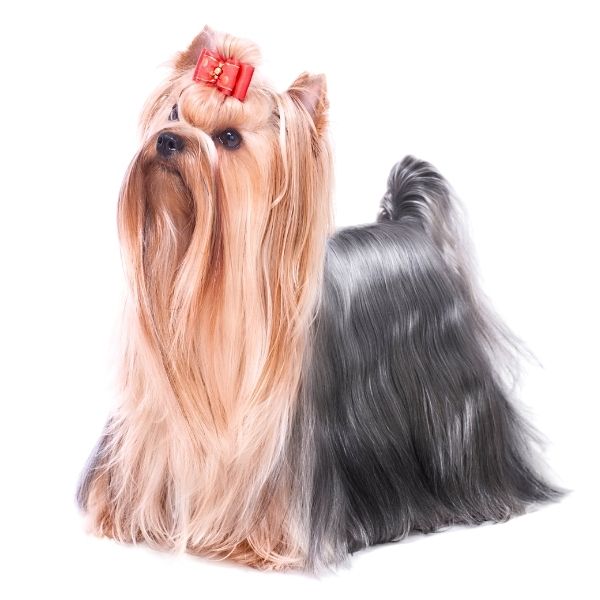 Black-based saddle pattern, faded black “Blue & Gold“ “Blue & Tan“ | 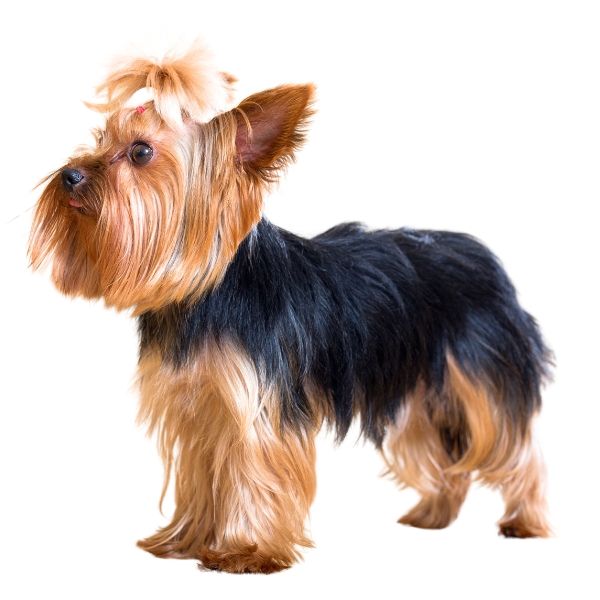 Black-based saddle pattern “Black & Gold“ “Black & Tan“ |
Yorkshire Terrier Color Overview
A short discussion of breed standard patterns in the Yorkshire Terrier:
Faded Black & Saddle Tan
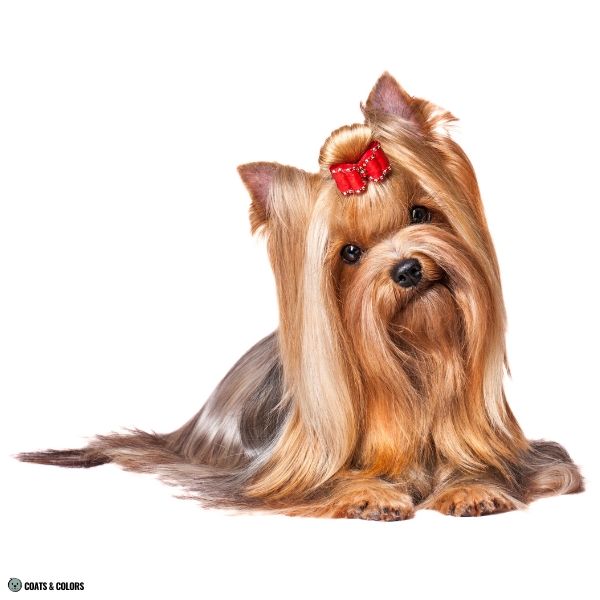
Yorkies are supposed to have a fading black-based saddle pattern.
However, like any saddle-patterned dog, they are born with a black & tan pattern.
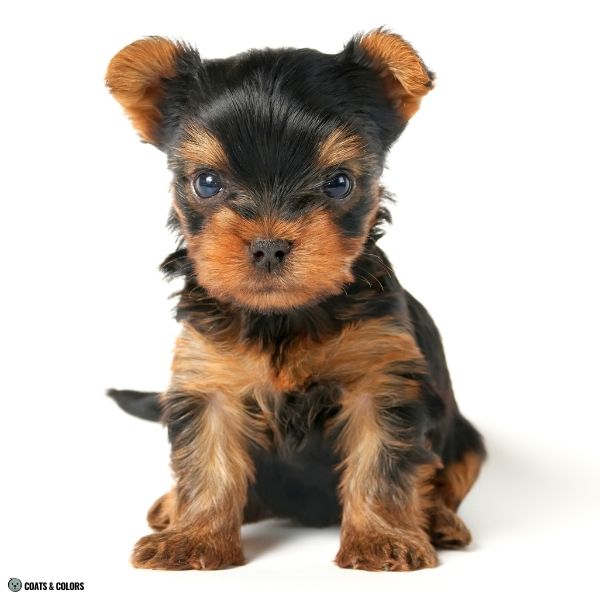
From there, two things need to happen that make them undergo a metamorphosis from a black & tan puppy coat into their faded black saddle & tan adult coat:
- Their tan areas get bigger until the black shrinks into a black saddle on their back.
- The pigment in their saddle progressively fades from black into a grayish “steel blue” color.
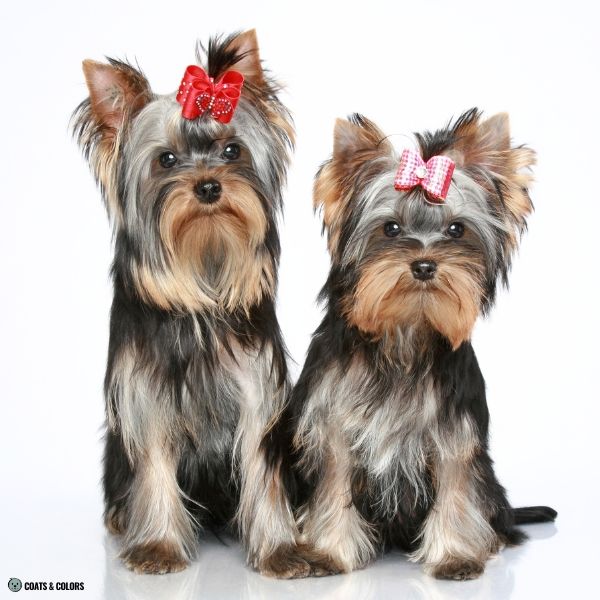
This change of color and pattern of course brings about some variability during the transition stages. Some Yorkies are said to take three or more years for their coat color pattern to mature!
Finally, their adult color pattern is called steel blue & tan, blue & tan, or blue & gold.
| E LOCUS | K LOCUS | A LOCUS | G LOCUS |
|---|---|---|---|
| E/E | ky/ky | asa/asa | G/- |
Yorkshire Terrier Color Genetics Summary
According to their breed standard, Yorkies only come in one pattern. But they are one of those breeds where a great number of dogs are bred for “rare colors“.
These are color traits that occur in Yorkshire Terriers:
| E LOCUS | Em = melanistic mask E = normal pattern eG = domino (rare!) e = recessive red (rare!) |
| K LOCUS | KB = dominant black (rare!) ky = normal pattern |
| A LOCUS | Ay = sable (rare!) asa = saddle pattern at = tan points (rare!) a = recessive black (rare!) Older testing methods can not detect the asa allele and will report it as at |
| B LOCUS | B = black b = brown (rare!) |
| D LOCUS | D = normal pigment d = diluted pigment (rare!) |
| G LOCUS theorized | G = progressive graying g = no graying |
| S LOCUS | S = no spotting sP = piebald spotting (rare!) |
| M LOCUS | M = merle (introduced) m = non-merle |
Yorkshire Terrier Colors
Yorkshire terriers express a saddle pattern with both types of pigment, faded black eumelanin and a medium to high intensity golden shade of phaeomelanin.
And coat colors and placement are quite important:
Color of hair on body and richness of tan on head and legs are of prime importance in adult dogs, to which the following color requirements apply:
Yorkshire Terrier AKC breed standard
Blue – Is a dark steel-blue, not a silver-blue and not mingled with fawn, bronzy or black hairs.
Tan – All tan hair is darker at the roots than in the middle, shading to still lighter tan at the tips. There should be no sooty or black hair intermingled with any of the tan.
Eumelanin
Show-line Yorkies are fixed for non-diluted black eumelanin (B/B D/D).
Their “steel blue” saddle pigment is nothing else but faded black.

Keep in mind, that “blue” is a breed term in Yorkies meaning faded black. It’s NOT the same as diluted black (B/- d/d) which would be called “born blue” in Yokie terms!
Pigment Fading
The breed is known for its progressive pigment fading.
Graying mostly affects eumelanin, turning any black coat in a Yorkies pattern lighter.
But it is thought to also sometimes affect phaeomelanin intensity.
Some owners believe that dogs with light tan also tend to have a lighter gray in their saddle. But there are many examples of dogs where this is not true (i.e. pale saddle on red tan, or a dark saddle on light tan).


Newborn puppies start out with a normal black and tan pattern. However, any black in the coat will shrink into a saddle pattern and, over time, grow out and fade to a grayish-blue shade.
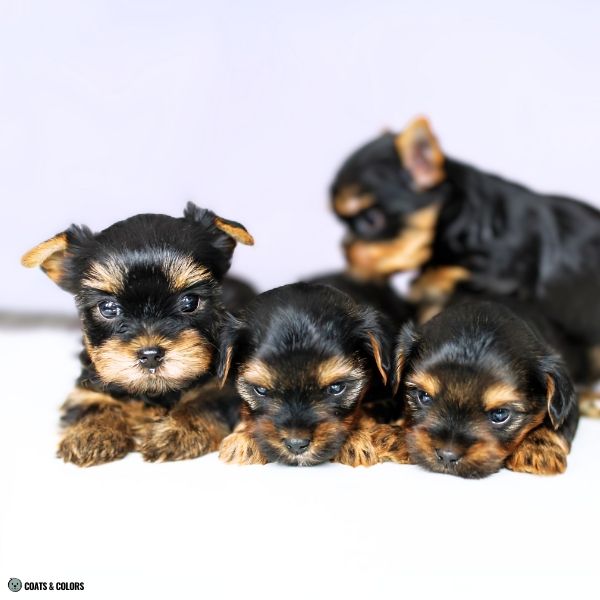
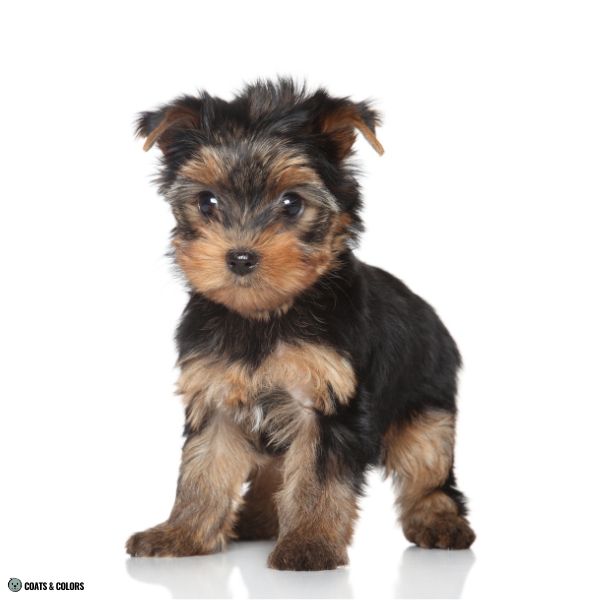

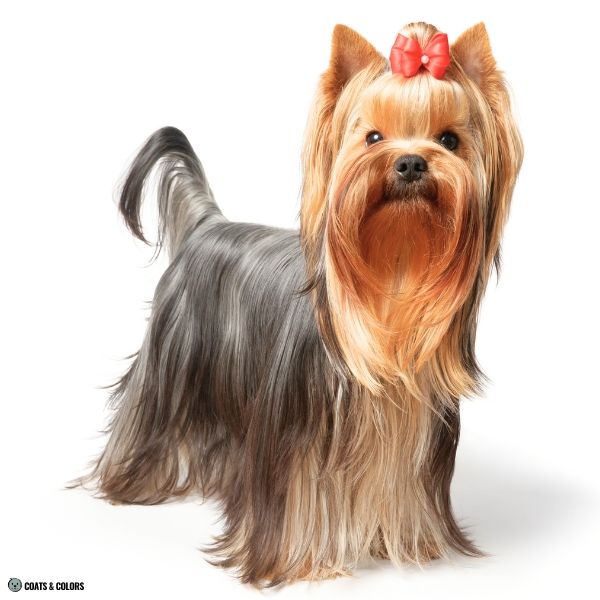
What Yorkie folks call “breaking blue” is the beginning of progressive graying seen in youngsters. Hairs along the back that still have a black tip will start to grow out lighter and lighter.
Almost always, the proper silky textured blue and gold bred dog will be broken blue down the part along the spine from four to six months of age, but this can vary with the darker ones taking longer.
Illustrated Discussion of the Yorkshire Terrier[4]
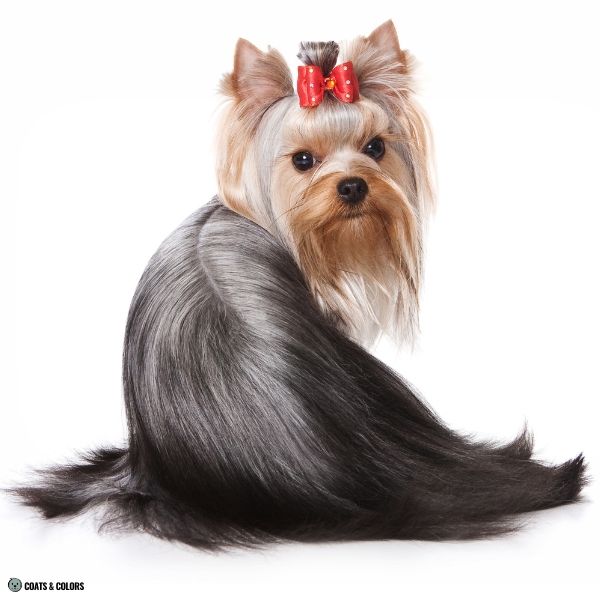
Progressive graying is only observed in furnished dogs.
Depending on coat texture, faded black can produce a peppered or dull grayish-blackish coat, e.g. in wirehaired Terriers or Irish Wolfhounds or curly-coated Poodles or Bedlingtons.
However, typical Yorkies have a very silky drop coat with a fine texture and very little undercoat.
The result is a quite uniform gray coat with a glossy finish. Still, the hair on the tail often keeps a darker shade of blue compared to a lighter grayish saddle area.
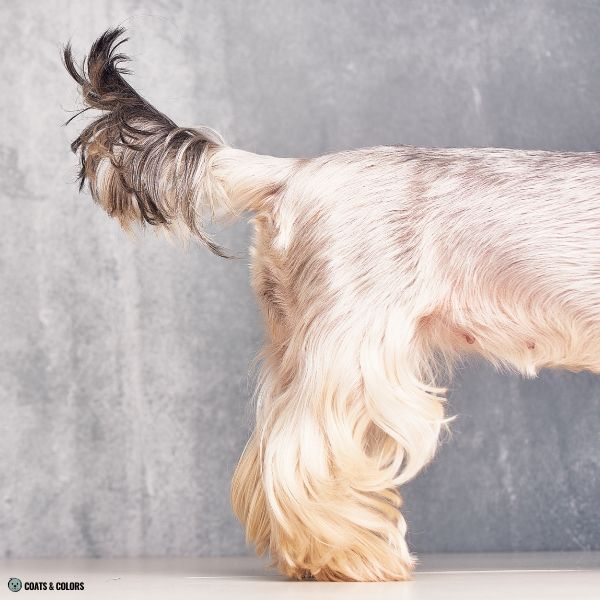
Hair on tail is a darker blue, especially at end of tail.
Yorkshire Terrier AKC breed standard
The genetics of pigment intensity and fading are not yet fully understood.
However, the effect of progressive graying seems to be dose-dependent.
The G locus has been established as a theoretical tool to explain graying.
Dogs with two copies (G/G) typically show stronger fading than dogs with only one copy (G/g). You would expect a G/G dog to have a lighter silvery coat and a G/g dog to have a darker grayish coat.
Depending on factors such as copy numbers and how strong the graying is, Yorkies can end up with any shade between a light silvery gray or a more blackish gray.
With the ideal being a medium blueish-gray steel blue color.
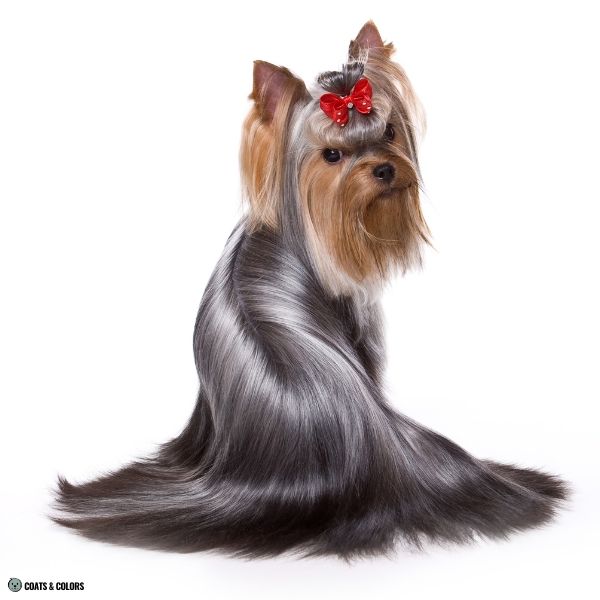
However, by far not all Yorkies end up with the desired medium gray color.
Sometimes, the saddle pigment can be too dark or too light.
Not only are some dogs homozygous (G/G) and some are heterozygous (G/g) for graying.
The effect of graying can also be stronger in some dogs than others!
This leads to a whole range of shades of gray in Yorkie markings.
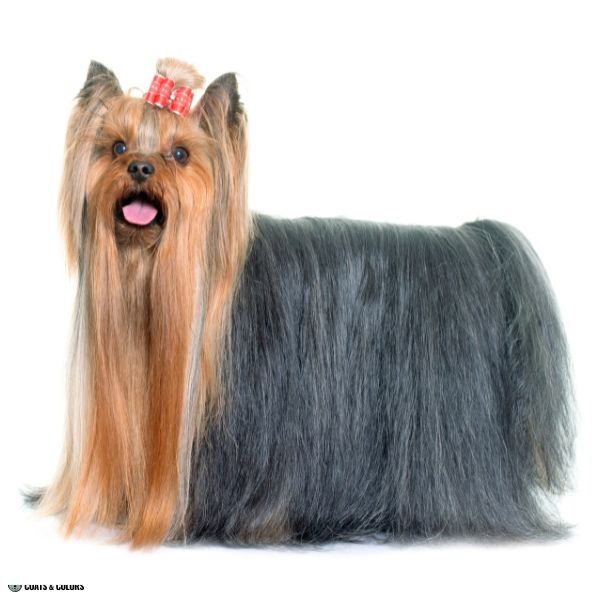
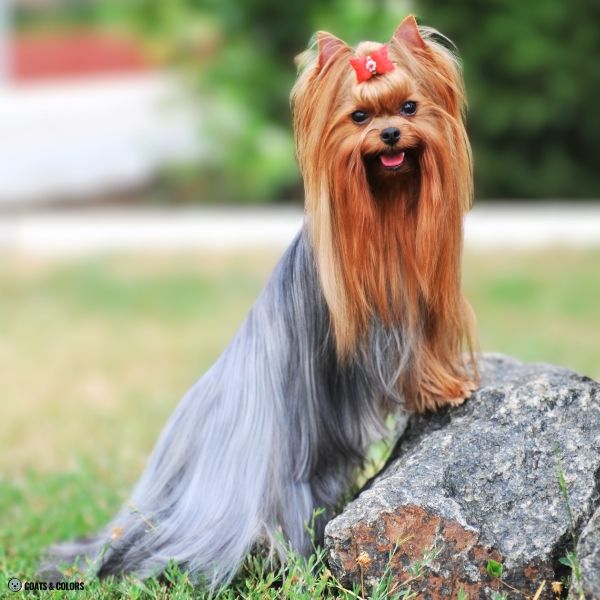
For example, dogs with only one copy of graying (G/g) and weak graying might take forever to fade.
Some of these dogs end up “nearer black in appearance” than their relatives. Which goes against the desired medium gray saddle without “any approach to blackness“[4].
Finally, breeding two heterozygous dogs (G/g x G/g) can produce puppies without any graying (g/g). The breed term for a saddle-patterned dog with no graying is “black & tan“.



But dark saddle pigment is not the only problem.
The breed standard also explicitly states that very pale silvery gray saddles are equally undesirable.
This “paIe silver” or “platinum silver” saddle can be the result of very strong graying on G/G dogs.
But most often pale saddles are associated with dogs whose saddle area is too small or starts to fade or has pale roots so that more and more golden tan hairs are visible on their back.
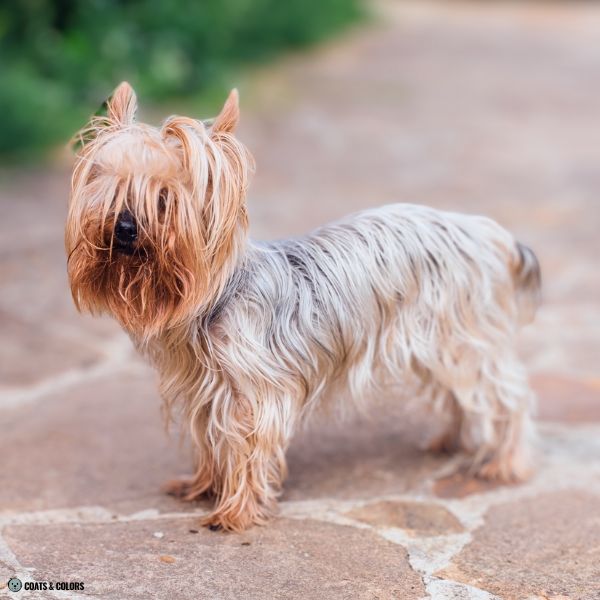
Last, but not least some other color anomalies can happen.
In rare cases, very long hairs can show long bands with slightly varying colors, e.g. due to heat cycles. This banding phenomenon can happen in any super-longhaired dog.
Clipping a dog with a fading pigment removes all the darker hair tips. So expect your Yorkie (especially puppies that still have black in their hair lengths) to look a lot paler after a first visit to the groomer.
Additionally, clipping can sometimes restart the fading process. Meaning that sometimes dogs grow black hairs on their back after grooming which then have to “break blue” all over again.
Phaeomelanin
The phaeomelanin portion of the Yorkie pattern comes in a range of shades from pale to dark tan.
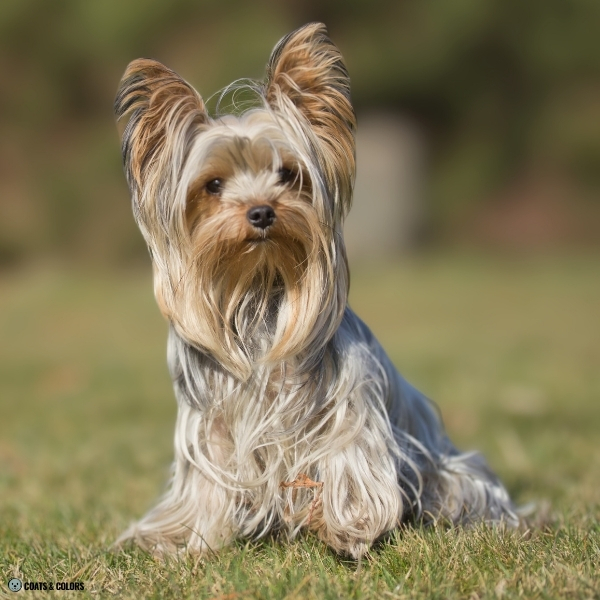
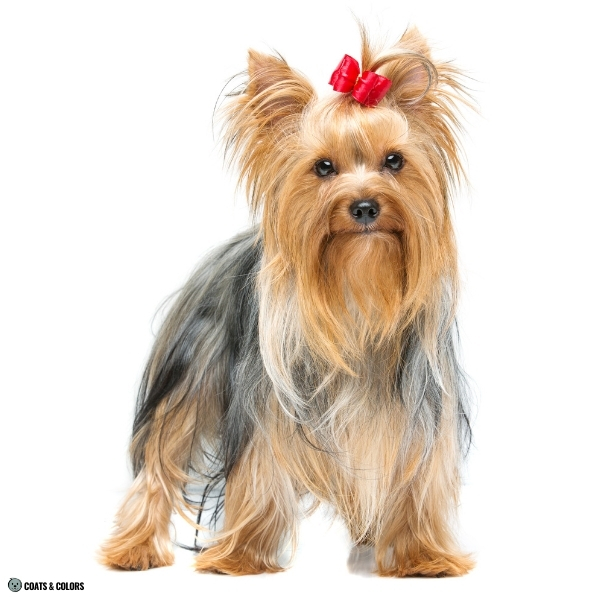
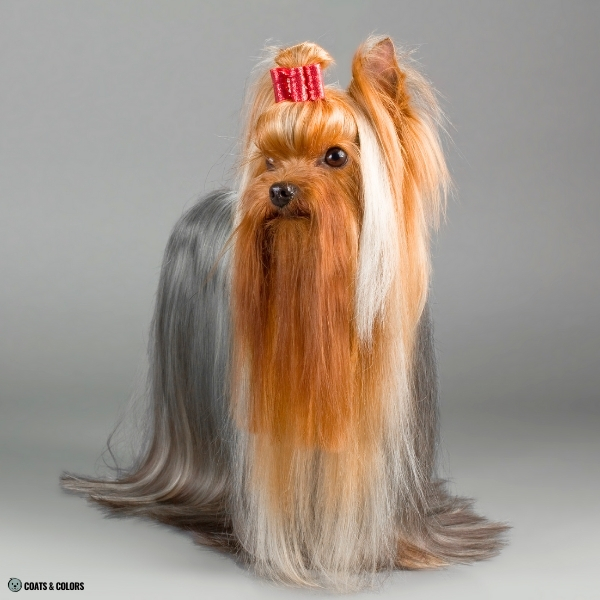
The official breed standards seem to favor an orangey yellow to a reddish yellow.
The AKC breed term for the ideal shade of tan is “gold“.
In comparison, the term “tan” is used for slightly lighter shades of phaeomelanin.
The FCI simply calls all of the accepted shades of red pigment in Yorkies a “rich bright tan“.
This much sought after gold is of a fine silky texture. It is a bright, rich, gleaming, brilliant golden hue, and will reflect light.
Illustrated Discussion of the Yorkshire Terrier[4]
The quality of gold on the ideal Yorkie can be likened to a new gold coin. It bears no semblance to a rust, ginger, or brownish mahogany hue. It does not appear to be a solid unshaded orangey red nor the red of an Irish Setter.
Another term used for phaeomelanin areas in Yorkies is “shaded tan” in reference to differences in pigment density depending on hair length and position.
The tan on the muzzle, sides of head, ears, and paws is often a little darker than the tan on the rest of the dog. And longer tan hairs are often a little darker at the roots lighter at the tips.
Headfall: A rich golden tan, deeper in color at sides of head, at ear roots and on the muzzle, with ears a deep rich tan.
Yorkshire Terrier AKC breed standard
White Spotting
Officially, there is no white spotting in Yorkies.
Disqualifications: […] Any white markings other than a small white spot on the forechest that does not exceed 1 inch at its longest dimension.
Yorkshire Terrier AKC breed standard
Dogs can still have some smallish white markings at birth.
These residual markings are usually located at the chest or the lower jaw or toes. These tiny patches of white coat tend to shrink and grow out or get buried under the long coat.

However, a small proportion of Yorkshire Terriers are piebald carriers (S/sP).
One dose of piebald can produce larger white markings on the lower body or front of the dog. And two doses of piebald (sP/sP) can create parti-colored Yorkies (think of Biewer Yorkies).
A Yorkie with white spotting is still a mismarked Yorkie and not the same as a purebred Biewer Terrier!
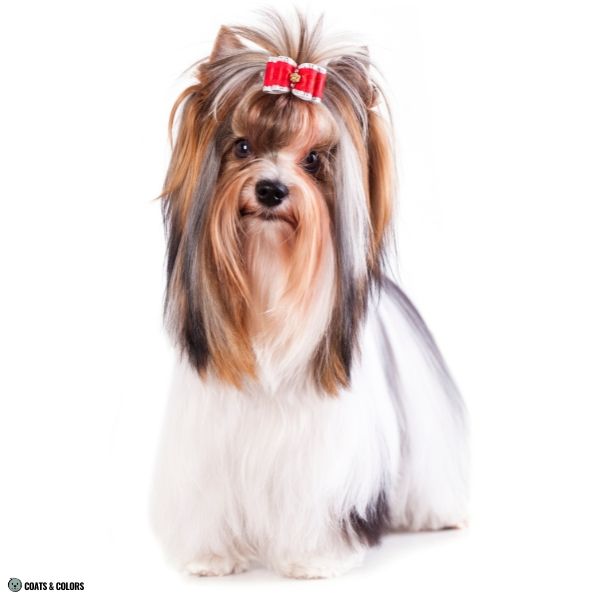
Eye Color
Yorkies have dark brownish eyes and black eye rims.
Nose Color
Being fixed for black eumelanin, all standard Yorkies have a black nose.
Occasionally, some black & tan or saddle-patterned dogs, including even a well-bred Yorkshire Terrier, may have fading nose pigment or a lighter stripe on the nose.
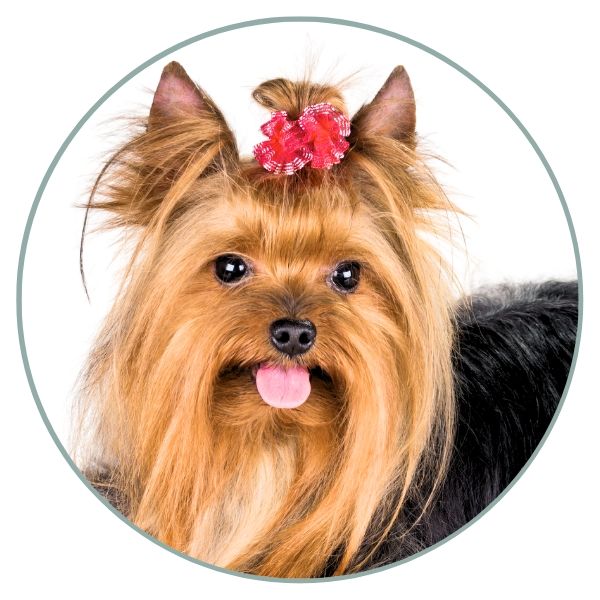
Yorkshire Terrier Patterns
All Yorkshire Terries look the same, they express a fading black-based saddle pattern.
Saddle and fading pigment are two completely separate traits, by the way.
Dogs can have a saddle without the graying (see German Shepherd Dogs or Airedale Terriers). And dogs without a saddle pattern can express graying (see Irish Wolfshounds or Bearded Collies).
A Locus
This breed is fixed for a saddle pattern (asa/asa).
The color placement in a Yorkie’s saddle pattern is of great importance.
Color on Body: The blue extends over the body from back of neck to root of tail.
Yorkshire Terrier AKC breed standard
Headfall: A rich golden tan […] with ears a deep rich tan. Tan color should not extend down on back of neck.
Chest and Legs: A bright, rich tan, not extending above the elbow on the forelegs nor above the stifle on the hind legs.
Colour: Dark steel blue […], extending from occiput to root of tail […]. Hair on chest rich, bright tan […]
Yorkshire Terrier FCI breed standard
Ears: […] colour very deep, rich tan.
Coat: Fall on head long, rich golden tan, […]. Tan on head not to extend on to neck, […]
Forequarters: […] well covered with hair of rich golden tan […] , not extending higher on forelegs than elbows.
Hindquarters: […] Well covered with hair of rich golden tan […], not extending higher on hind legs than stifle […]
The saddle in Yorkies is supposed to cover quite a large area and be as solid as possible in color.
Other breeds with a saddle pattern allow for more variation in their saddle patterns.
Saddles can be big or small, they can cover the shoulders or form a half circle across the chest.
It’s also quite normal for dogs with this pattern to have some black hairs in their tan areas or a slightly grizzled saddle with intermingling tan hairs.
Oftentimes, black saddles wash out even more over time.
Here are some saddle-patterned dogs for comparison:

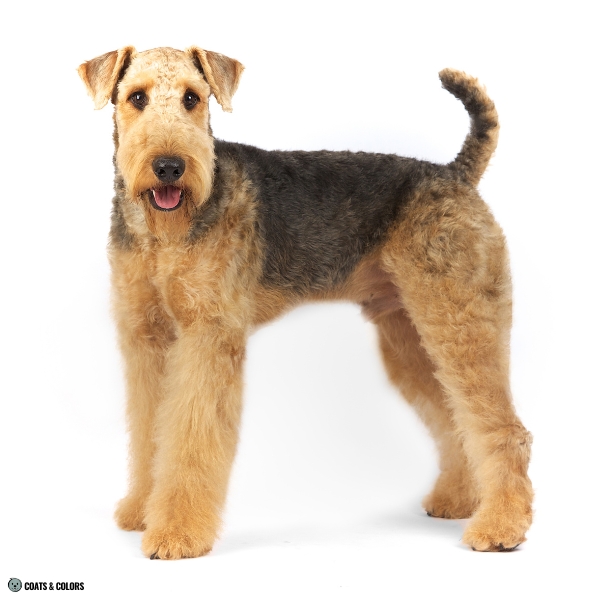
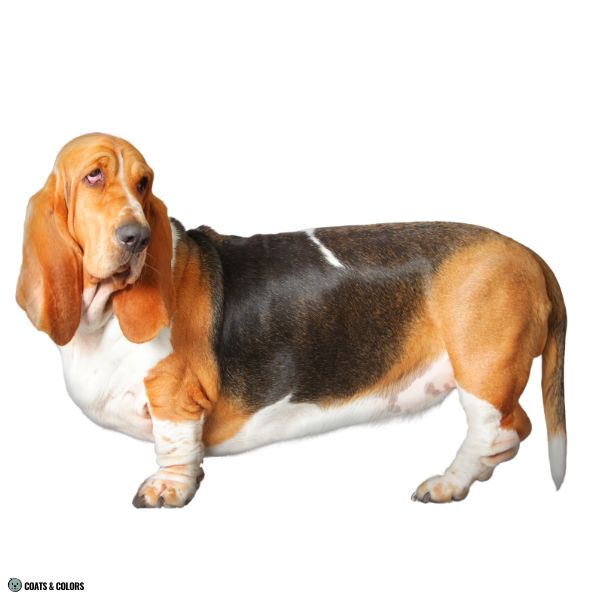
But in Yorkies, the saddle is meant to be as solid in color as possible.
Additionally, the tan is meant to not come quite as far up on the body as in other saddle tan breeds.
The Yorkie saddle covers the whole back right from the back of the neck to the tail. It also extends further down to cover the thighs and upper arms down to the hocks and elbows.
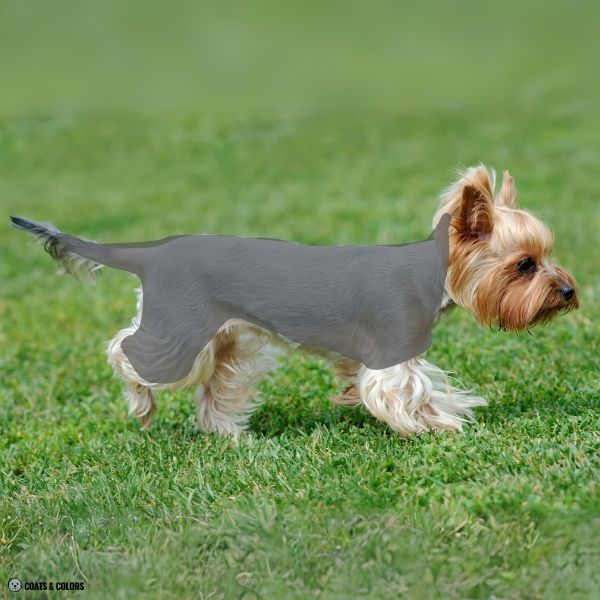


The front or the chest of a Yorkshire Terrier is all shaded gold. There are no sooty or visible dark hairs or any small “half circle” break from under chin to the chest.
Illustrated Discussion of the Yorkshire Terrier[4]
An adult Yorkshire Terrier is supposed to have a solid tan chest with a fully tan head and headfall ( the long hair overhanging the sides of the face) without any black hairs in them.
They are not supposed to have any blue hairs in their golden coat.
So for example, no toe pencilling and ideally no stray black hairs on their head or across the chest.
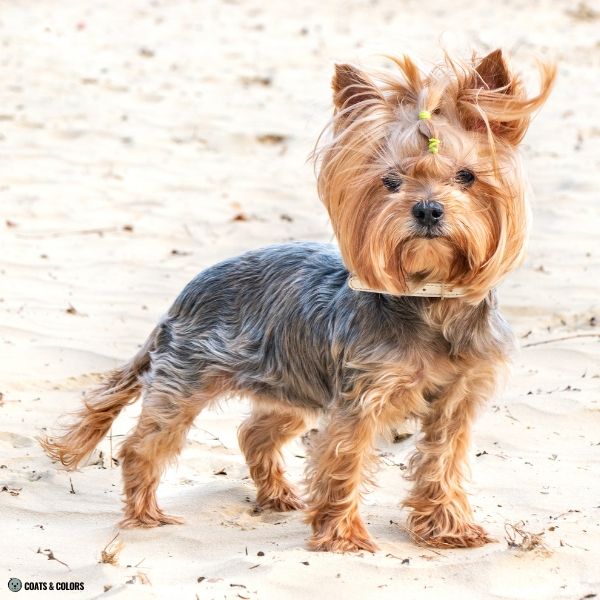
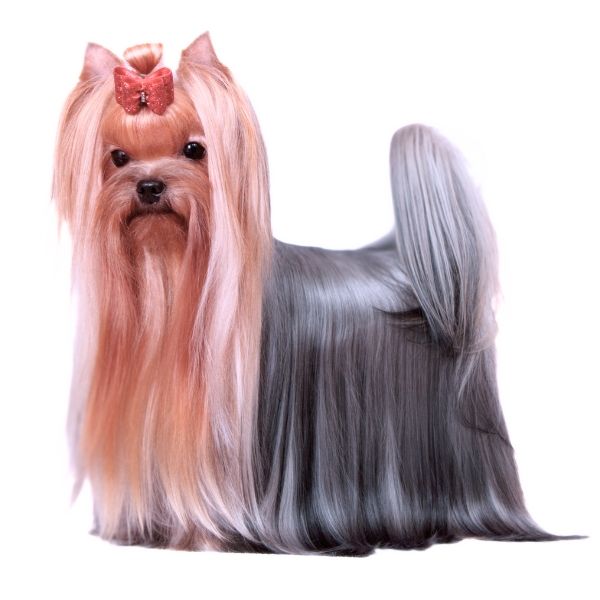
Only puppies and youngsters can have an intermingling of black hair in the tan areas.
A sooty or smutty look is normal during their transition from black & tan to saddle markings.
The black hairs on the side of the head and the back of the ears are usually the last to clear.

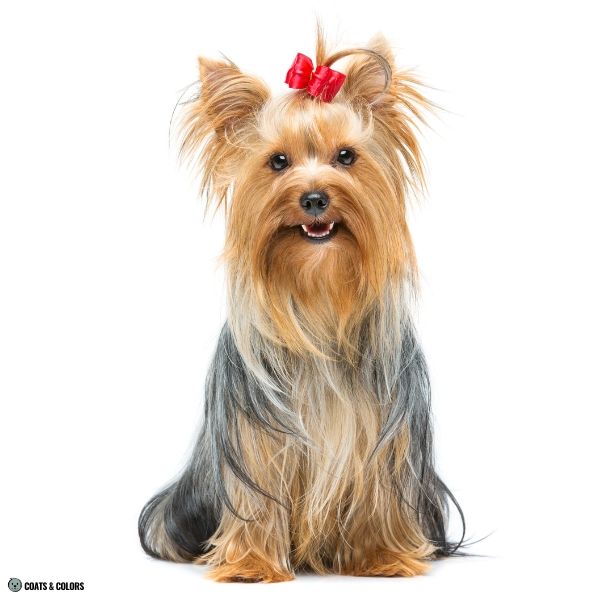
Likewise, Yorkies should not have any golden hairs in their blue saddle.
Tan hairs or many long pale roots growing inside the blue saddle area can cause too pale a saddle pattern.
In Yorkshire Terriers, this phenomenon is called “running gold“.


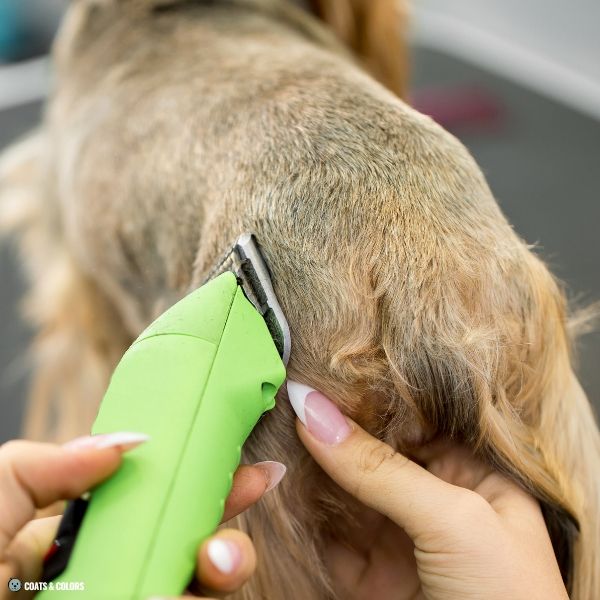
Unfortunately, it’s quite normal for dogs with a saddle pattern to have an intermingling of black and tan hairs in their saddle area. Or the saddle area to fade and shrink over time.
This can get quite extreme to the point where the pattern can get so yellow his coat resembles a sable pattern. Quite the fascinating transformation on a dog that was born almost black, isn’t it?
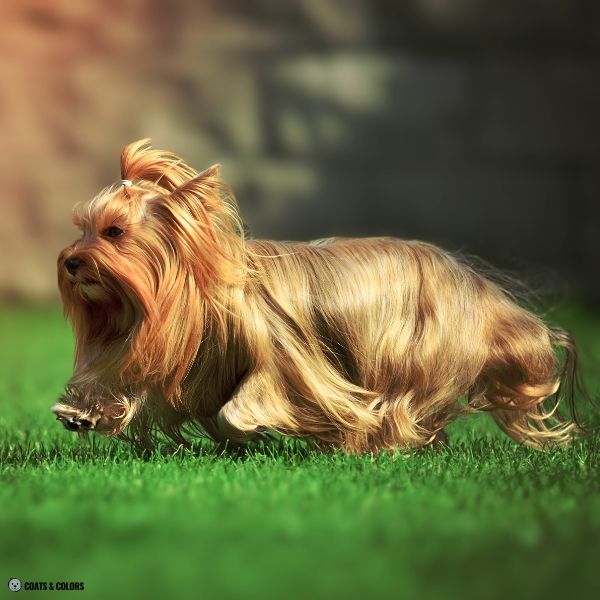
“Running color” means that the tan color markings […] have exceeded their borders, and the tan extension has given a fawn or bronzy appearance into the blue areas of the coat. These “running tan”, fawn or bronzy areas can be observed below the occiput, around the tail set and the shoulder areas.
Illustrated Discussion of the Yorkshire Terrier[4]
In summary:
What makes the Yorkie saddle pattern a little special is that they have been bred for…
1) …an as solid golden as possible tan area
2) …an as solid gray as possible saddle area
3) …a specific placement of both pigment types
3) …quite clean edges between the two pigment types
K Locus
All Yorkies are fixed for normal pattern with clear tan (ky/ky) areas.
They neither come in brindle (kbr) nor dominant black (KB).
E Locus
Yorkies are mostly fixed for the wild-type E locus allele (E/E).
Some Yorkies seem to test positive for a melanistic mask (Em).
But to be honest, I have no idea if this is one of the breeds that test positive but don’t express a mask. Or if masks really are a thing in pet line Yorkies where they might have been introduced.
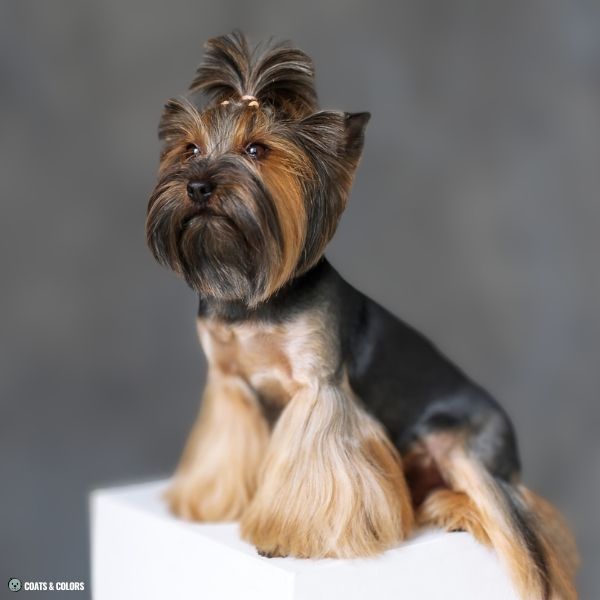
Interestingly, a small number of Yorkies seem to carry a domino variant (E/eG)[3].
Given the low frequency, it’s highly unlikely to produce a saddle domino Yorkie. Affected puppies (eG/–) are expected to have a light tan and a smallish saddle with lots of “running gold“, I guess.
If you want an example of saddle domino, search for “badger-pied” in the Beagle blog post.
Mismarks and Fancy Colors
Yorkies are one of those breeds where color-breeding in pet dogs is super common.
There are some recessive traits present in standard-bred Yorkies, e.g. non-graying (g), recessive red (e), tan points (at), chocolate (b), or color dilution (d).
All of these traits are recessive to whatever a standard Yorkie should have at their respective locus. Unknowingly breeding with carriers can result in puppies expressing these recessive traits.
But let’s be real, color breeders rarely wait around for rare mismarks to “just happen” on their own.
Many pet line Yorkies come in a variety of fancy colors, most of them introduced on purpose into the breed by crossbreeding with other toy dogs such as Chihuahuas or Maltese.
Disqualifications: Disqualifications: Any solid color or combination of colors other than blue and tan […]
Yorkshire Terrier AKC breed standard
There is quite a number of non-standard colors in the Yorkshire Terrier.
Many color-line Yorkies don’t have progressive fading (g/g).
In breed terms, a “black & tan” Yorkie is a saddle-patterned dog without the graying.
Breeders claim that these “black woolly” dogs have a more dense and cottony soft coat. However, to my knowledge graying should not make a huge difference regarding coat “wooliness”.
Atypical soft coat texture is a problem in many Yorkies, not just the black ones.

Some Yorkies keep their tan point pattern (ky/ky at/at). Tan point carriers (ky/ky asa/at) might express creeping tan with black not fully receding from the tan areas and an overall smutty look.
A small number of Yorkies carry a tan point pattern (asa/at). This can produce an intermediate creeping tan phenotype with the black often not fully receding from the face markings or chest.
Finally, dogs born with two copies of tan points (at/at) will keep the black & tan pattern they are born with, with or without the graying.
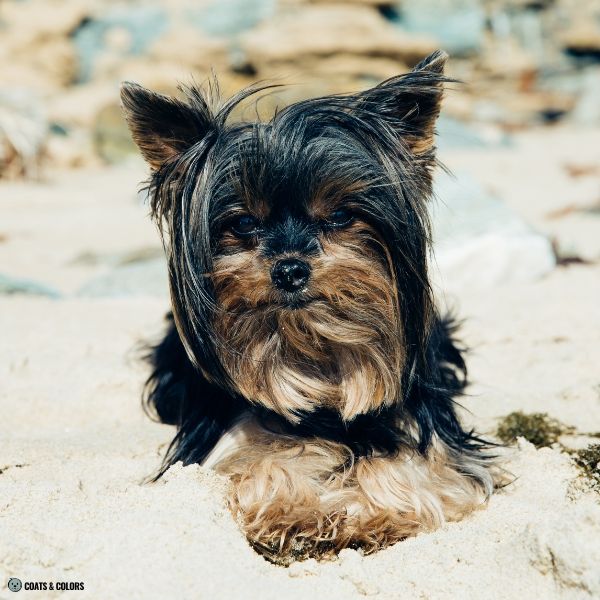
Chocolate is an eumelanin modifier (b/b).
It will turn all the black areas to brown, including the nose and skin pigment.
It often causes a yellowish eye color. Any pattern can be brown-based, from solid chocolate to chocolate & tan, chocolate sable, or chocolate saddle patterns.
If a brown-based dog also has progressive fading, all the brown will turn to a lighter beige color.
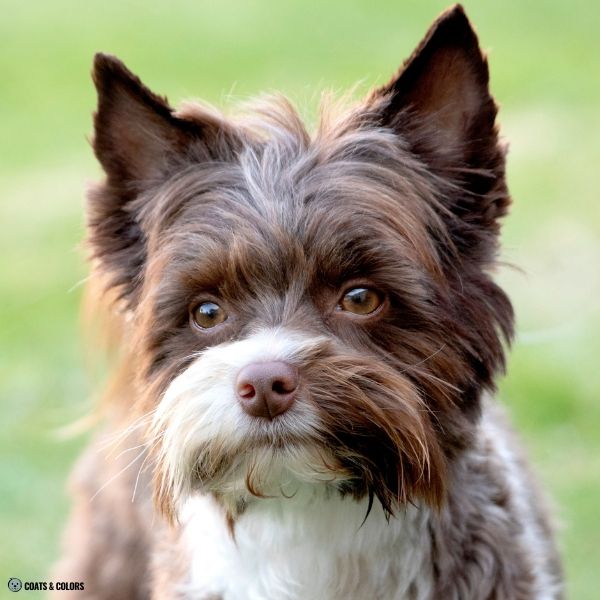
Color dilution (d/d) turns all the eumelanin to a lighter shade, from black to blue or from chocolate to lilac.
This is not the same as progressive fading, diluted dogs are already born with their light pigment and will also have a blue nose. When combined with fading, a “born blue” dog can lighten into a very pale silver.
If I manage to find an image of a “born blue” Yorkie, I’ll include it here!
Parti-colored Yorkies express piebald spotting (S/sP or sP/sP).
Black tricolor was the pattern that initially led to the breeding of Biewer Terriers.
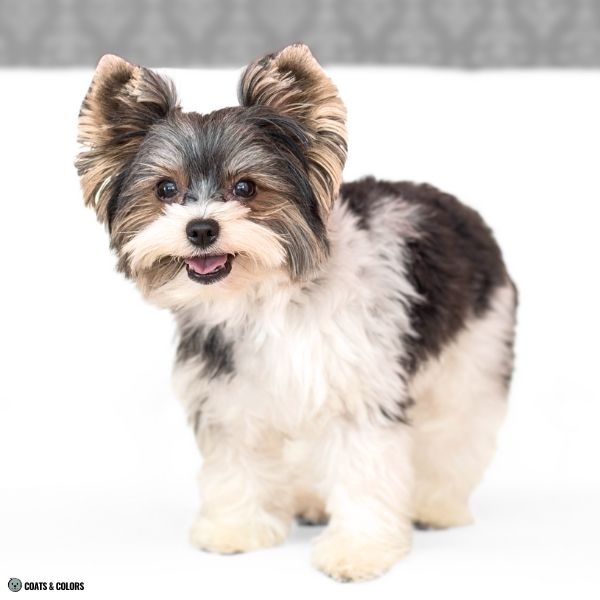
Solid cream, yellow, gold or red Yorkies express recessive red (e/e).

Some Yorkies come in clear or shaded sable (ky/ky Ay/Ay). Sable patterns can be black- or chocolate-based.
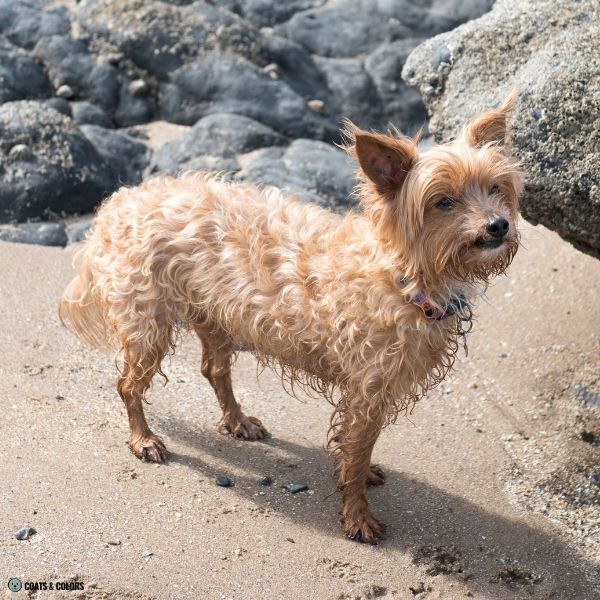
Solid black, chocolate, blue or lilac Yorkies express dominant black (KB/-) or recessive black (ky/ky a/a).
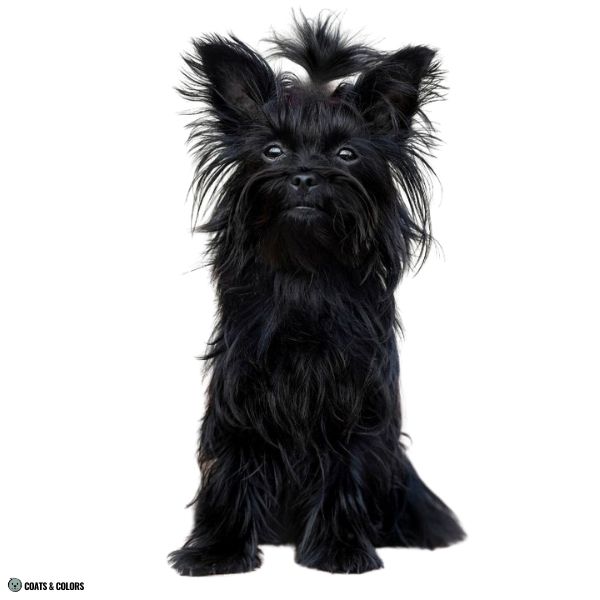
Brindle Yorkies (kbr/-) will have dark stripes on all of their tan areas, expected patterns in pet Yorkies would be brindle points, saddle brindle, or sable brindle.
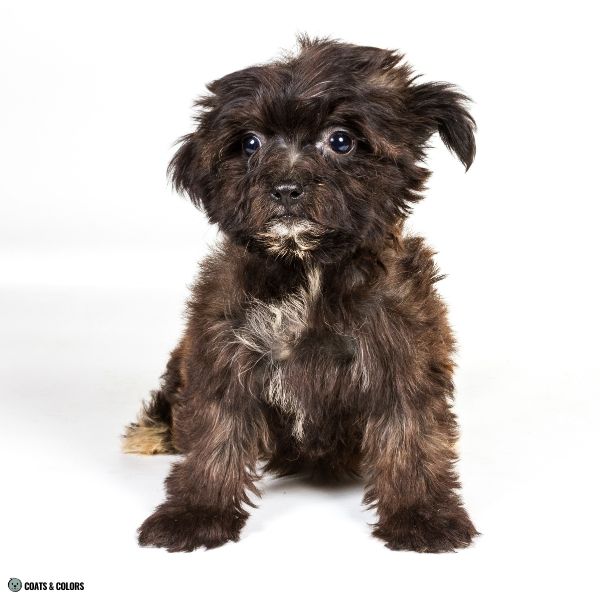
Merle (M*/-) can dilute random parts of any eumelanin in a Yorkie’s coat.
Again, I’ll have to search for an image of a merled Yorkie to include here.
The Yorkie Club Of America warns that “off-colored” dogs might suffer from health defects[7].
They claim that new colors are genetic defects and can lead to skin problems, allergies, hair loss, long-term illness and/or death[5]. I get that they roll their eyes at non-standard colors, but that goes a bit far.
It’s not per se the new colors that cause problems down the line (except of course merle, color dilution, or extreme white piebald when bred irresponsibly).
The real problem is the breeding ethics of backyard breeders and puppy mills that make rare colors their top priority in breeding (opposite to health or temperament).
Learn More
Links
[1] American Kennel Club (AKC): Official Standard for the Yorkshire Terrier (pdf)
[2] Fédération Cynologique Internationale (FCI): Yorkshire Terrier Breed Standard
[3] Dreger et al. (2019). True Colors: Commercially-acquired morphological genotypes reveal hidden allele variation among dog breeds, informing both trait ancestry and breed potential. PLoS ONE 14(10): e0223995. https://doi.org/10.1371/journal.pone.0223995
[4] The Yorkshire Terrier Club of America: Judges Education
[5] The Yorkshire Terrier Club of America: An Important Note About Color in Yorkshire Terriers (pdf)
[6] The Yorkshire Terrier Club of America: Parti-Color Yorkshire Terriers?
[7] National Purebred Dog Day: Combinations of Black, Tan, Gold and Blue
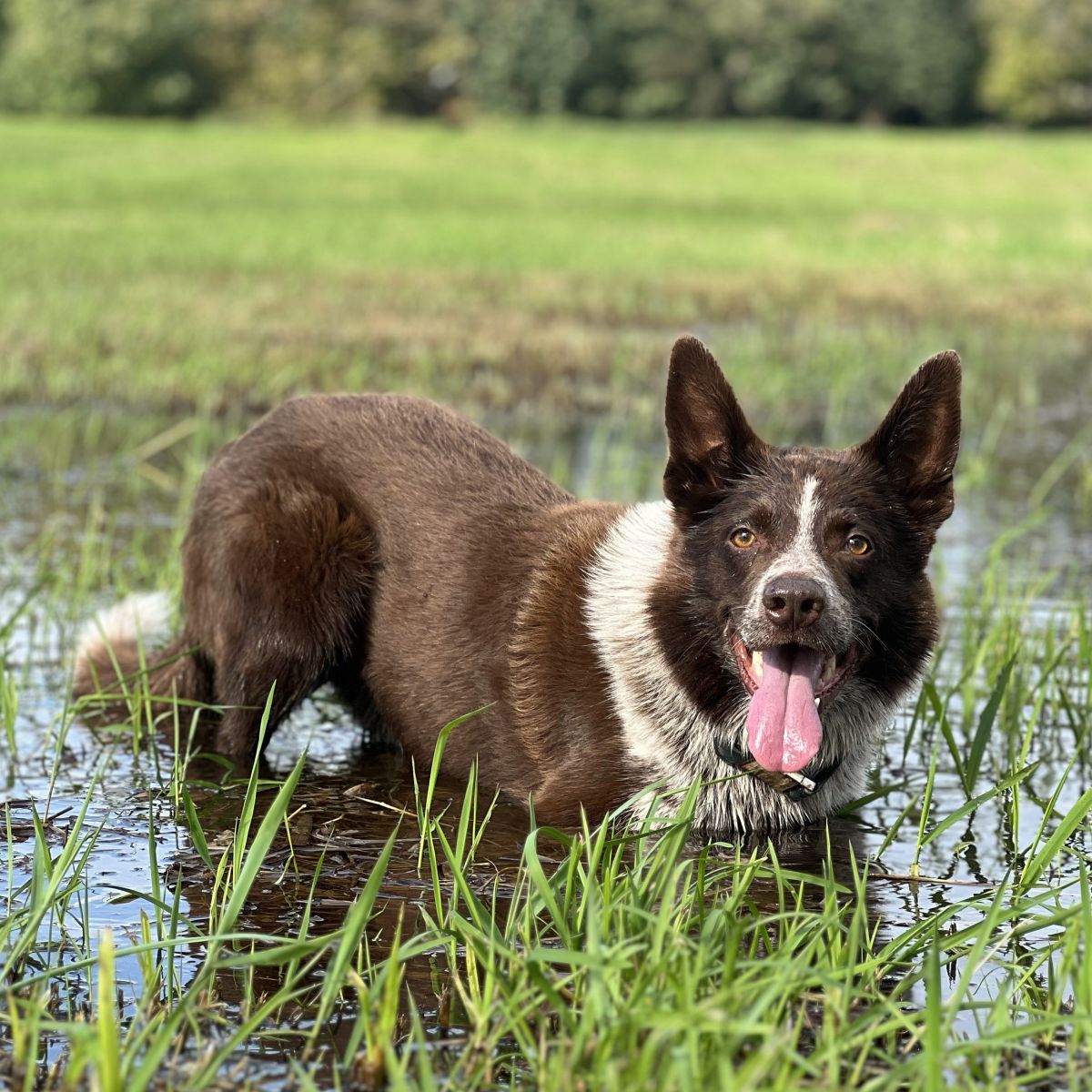
Hi! I’m Steffi. I am a biologist and a big time dog nerd. You are curious about coat color genetics? You’ve come to the right place! Read more.

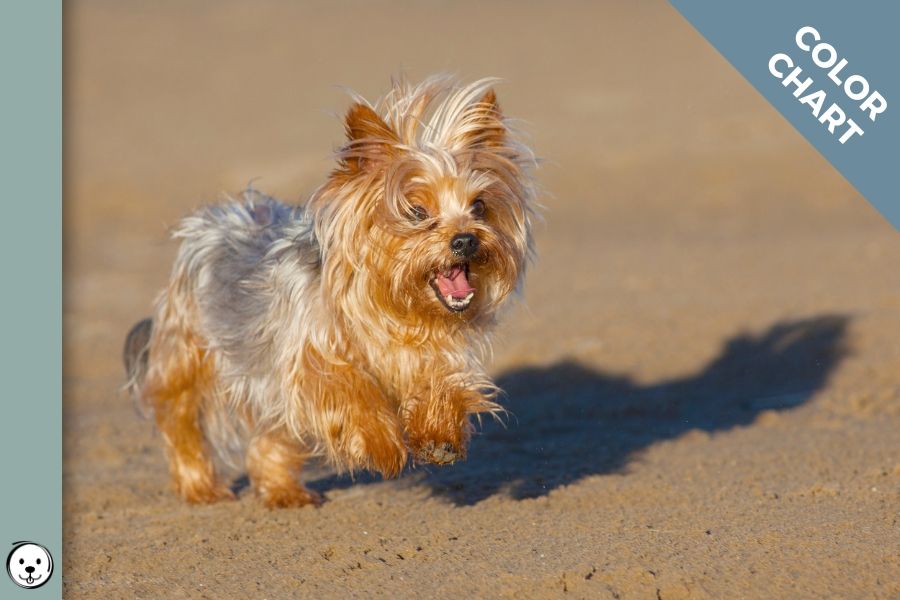
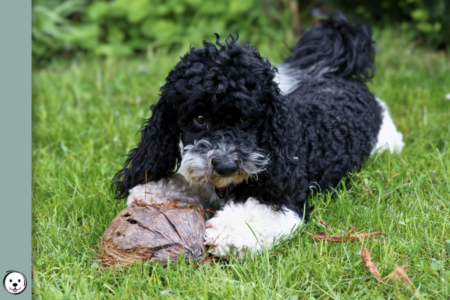



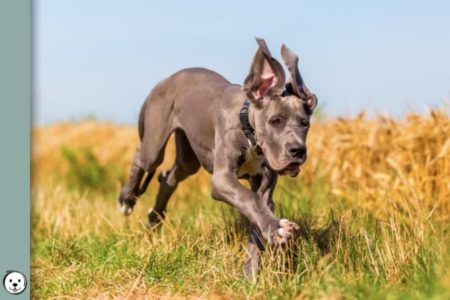
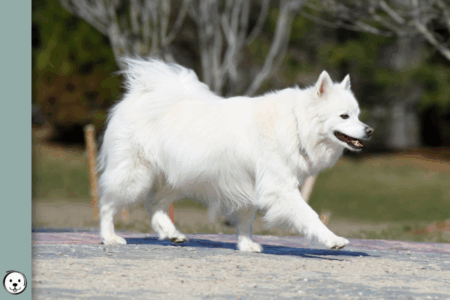
1 thought on “Yorkshire Terrier Color Chart”
Comments are closed.